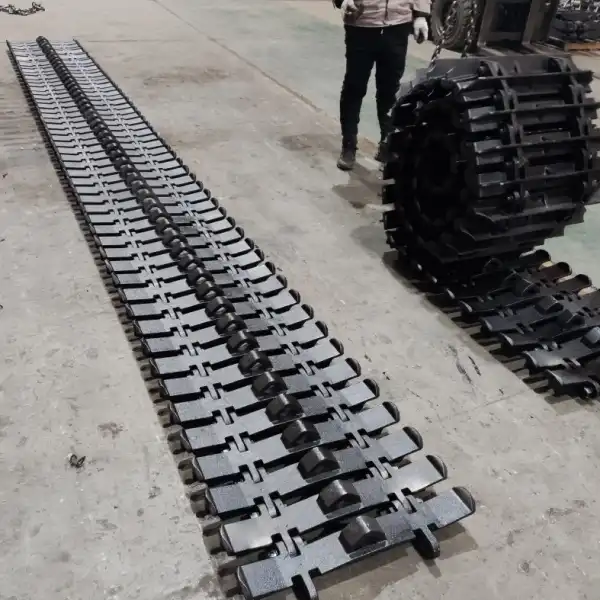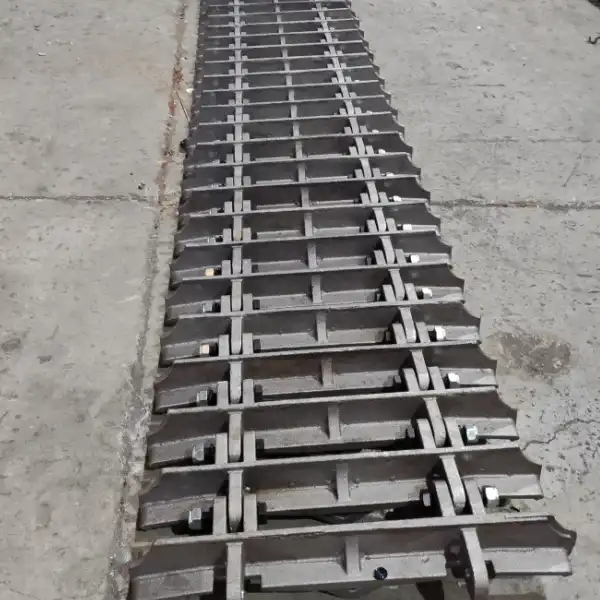How Do Anti-Skid Tracks Enhance Truck Safety in Harsh Conditions?
When heavy-duty trucks navigate through treacherous weather conditions, safety becomes paramount for both operators and surrounding traffic. Truck anti-skid track systems serve as critical safety equipment that transforms potentially hazardous journeys into manageable operations. These sophisticated traction devices work by creating additional contact points between tires and road surfaces, dramatically reducing the likelihood of losing control during challenging weather events. The physics behind their effectiveness involves distributing vehicle weight across expanded surface areas while providing mechanical grip that standard tires cannot achieve alone. Understanding how these systems enhance safety can help fleet managers, construction supervisors, and equipment operators make informed decisions about protecting their most valuable assets - their personnel and machinery - when facing adverse environmental conditions that threaten operational continuity and worker well-being.

Enhanced Traction on Slippery Surfaces
Slippery road conditions present some of the most dangerous scenarios for heavy vehicle operations, where conventional tire tread patterns become insufficient for maintaining adequate grip and control.
Snow and Ice Performance Characteristics
When temperatures drop and precipitation accumulates, truck anti-skid tracks are designed to improve traction and stability in challenging road conditions, such as muddy, icy, or snow-covered surfaces. The mechanical advantage provided by track systems comes from their ability to bite through surface snow layers and establish contact with underlying pavement or packed surfaces.
Ice conditions particularly benefit from track installation because the metallic construction creates micro-fractures in ice surfaces, generating friction where smooth tires would simply slide. Professional drivers report significant improvements in vehicle controllability when equipped with proper track systems, transforming white-knuckle driving experiences into manageable transportation tasks.
Temperature variations affect track performance differently than standard tires, with metal components maintaining consistent grip characteristics across extreme temperature ranges. This reliability proves crucial for emergency response vehicles, construction crews, and logistics operations that cannot afford weather-related delays or safety compromises.
Wet Road Surface Management
Rainy conditions create hydroplaning risks that endanger heavy vehicles due to their momentum and stopping distances. Anti-skid tracks combat this phenomenon through improved water displacement and increased surface contact pressure that maintains tire-to-pavement connection even during heavy downpours.
The drainage characteristics of track systems channel water away from contact patches more effectively than traditional tire treads, preventing the buildup of water films that cause loss of traction. This enhanced water management becomes particularly important for vehicles carrying heavy loads or operating on grades where maintaining control requires maximum available traction.
Professional installations include drainage considerations that complement existing tire patterns, creating comprehensive water management systems that perform reliably across various precipitation intensities and road surface conditions.
Multi-Surface Adaptability
Modern truck anti-skid track systems demonstrate remarkable versatility across different slippery surface types, automatically adjusting their grip characteristics based on encountered conditions. This adaptability eliminates the need for drivers to constantly modify their equipment or driving techniques when transitioning between different surface conditions during single journeys.
The self-cleaning properties of quality track designs prevent ice and snow accumulation that could compromise performance, maintaining consistent traction levels throughout extended operating periods. Fleet operators appreciate this reliability because it reduces maintenance interventions and operational disruptions during critical weather events.
Improved Grip in Soft or Unstable Terrains (Mud, Sand, Gravel)
Off-road and construction environments present unique challenges where standard tires struggle to maintain traction on surfaces that shift, compress, or lack structural integrity.
Mud and Soft Ground Navigation
By maximizing the produced friction that occurs on the impact of road and tire, traction control in heavy machinery limits tire slippage, and truck anti-skid tracks amplify this effect significantly in muddy conditions. The expanded contact area distributes vehicle weight more evenly, preventing the sinking that typically occurs when standard tires encounter soft terrain.
Construction sites during rainy seasons become accessible to tracked vehicles when wheeled equipment would become immobilized. This capability maintains project schedules and prevents costly delays associated with weather-related work stoppages. Excavator operators and heavy truck drivers working in these conditions rely on track systems to maintain productivity while ensuring safety.
The self-cleaning action of the moving truck's anti-skid tracks prevents mud accumulation that would otherwise reduce traction effectiveness, maintaining consistent performance throughout demanding workdays. This reliability proves essential for operations where equipment immobilization could endanger personnel or compromise project timelines.
Sandy Terrain Performance
Sandy environments, whether natural desert conditions or construction site backfill areas, require specialized traction solutions that prevent wheel spin and maintain forward momentum. Track systems create broader footprints that distribute loads across larger surface areas, preventing the digging action that immobilizes conventional wheeled vehicles.
The mechanical advantage provided by truck anti-skid tracks allows vehicles to climb sandy slopes and navigate loose aggregate materials that would challenge standard tire configurations. This capability proves particularly valuable for mining operations, coastal construction projects, and desert logistics applications where mobility directly impacts operational success.
Professional-grade systems incorporate design features that resist sand infiltration into mechanical components, ensuring reliable operation throughout extended exposure to abrasive conditions. Fleet managers value this durability because it reduces maintenance costs and equipment downtime in challenging environments.
Gravel and Loose Aggregate Handling
Unpaved roads and construction access routes often feature loose gravel surfaces that challenge vehicle stability and traction. Truck anti-skid track systems excel in these conditions by creating mechanical interlocks with aggregate materials that provide superior grip compared to smooth tire surfaces.
The ability to maintain traction on loose materials enables safe navigation of temporary construction roads, mining access routes, and emergency response paths where surface preparation may be minimal. This capability ensures operational continuity when standard vehicles might require extensive road preparation or become unable to access critical locations.
Track systems also reduce surface damage compared to spinning wheels, preserving road integrity while maintaining vehicle mobility. This consideration becomes important for projects requiring repeated access over temporary roadways where surface degradation could compromise future operations.

Enhanced Braking and Steering Control
Vehicle control during deceleration and directional changes represents perhaps the most critical safety aspect where anti-skid tracks provide measurable improvements over conventional tire systems.
Braking Performance Optimization
Enhanced surface contact provided by track systems dramatically improves braking effectiveness, particularly crucial for heavy vehicles where momentum creates substantial stopping challenges. In testing, a 30% improvement in braking performance was noted with advanced traction systems, and truck anti-skid tracks provide similar benefits through mechanical rather than electronic means.
The increased contact patch area allows brake systems to transfer more stopping force to the ground without inducing wheel lockup, maintaining steering control throughout emergency braking scenarios. Professional drivers report greater confidence when approaching intersections or navigating downhill grades in adverse conditions.
Track systems complement existing anti-lock braking systems by providing the mechanical grip necessary for electronic safety systems to function effectively. This synergy between mechanical and electronic safety technologies creates comprehensive braking performance that exceeds either system's individual capabilities.
Steering Response and Stability
Lateral grip provided by properly installed truck anti-skid track systems enhances steering response and vehicle stability during cornering maneuvers, particularly critical when carrying heavy loads or operating in windy conditions. The expanded contact area resists lateral forces that could cause skidding or loss of directional control.
Professional drivers appreciate the improved feedback and predictable handling characteristics that tracks provide, enabling more precise vehicle positioning in tight spaces or challenging terrain. This enhanced control capability proves particularly valuable for construction equipment operators working in confined areas where precision directly impacts safety.
The stability improvements extend to highway operations where crosswinds, passing traffic, and road surface irregularities can challenge vehicle control. Track-equipped vehicles demonstrate superior resistance to external forces that might compromise directional stability.
Emergency Maneuver Capability
Truck anti-skid track systems provide crucial safety margins during emergency situations requiring sudden directional changes or evasive maneuvers. The enhanced grip available through track systems enables drivers to maintain control during situations where conventional tires might lose traction.
Professional training programs emphasize how track-equipped vehicles can safely execute emergency procedures that might be impossible with standard tire configurations, potentially preventing accidents that could result in equipment damage or personnel injury. This capability represents a critical safety investment for operations in high-risk environments.
The psychological benefits of improved control cannot be understated, as confident operators make better decisions and maintain higher safety standards when they trust their equipment's capabilities. This human factor consideration often proves as important as the mechanical advantages in promoting overall operational safety.
FAQ
①How do anti-skid tracks improve truck safety in harsh weather?
Anti-skid tracks enhance safety by providing superior traction, improved braking performance, and better steering control in snow, ice, mud, and wet conditions where standard tires lose effectiveness.
②What types of harsh conditions benefit most from anti-skid tracks?
Muddy construction sites, icy roads, sandy terrain, wet pavement, and loose gravel surfaces all benefit significantly from enhanced traction provided by professional-grade track systems.
③Do anti-skid tracks work with existing vehicle safety systems?
Yes, tracks complement ABS brakes, traction control, and stability systems by providing the mechanical grip these electronic systems need to function effectively in challenging conditions.
④How much do anti-skid tracks weigh and affect vehicle performance?
Professional systems typically weigh around 750 kilograms per tire but improve overall vehicle performance and safety margins significantly, making the weight penalty worthwhile for harsh condition operations.
⑤Can tracks be installed on any dual-axle truck?
Most dual-axle vehicles can accommodate standard track systems, though proper sizing and professional installation ensure optimal performance and safety benefits.
Anti-skid track systems represent essential safety equipment for operations where harsh conditions threaten vehicle control and operator safety. The enhanced traction, improved braking performance, and superior steering control provided by TianNuo Machinery's truck anti-skid track installations create measurable safety improvements that protect both personnel and equipment investments. Professional fleet managers understand that the upfront investment in quality track systems pays dividends through reduced accident risks, improved operational capabilities, and enhanced driver confidence across challenging environments. Whether navigating construction sites during rainy seasons, maintaining logistics operations through winter storms, or accessing remote locations across difficult terrain, properly selected and installed track systems provide the safety margins necessary for successful operations.
Comprehensive safety planning includes evaluating traction enhancement options that match specific operational requirements and environmental challenges. Contact our safety equipment specialists at tn@stnd-machinery.com for professional consultation on anti-skid track systems tailored to your fleet's safety needs and operational demands.
References
- Vehicle Safety Systems and Traction Enhancement Technologies, Journal of Transportation Safety Engineering, Vol. 28, 2024
- Anti-Skid Track Performance Analysis in Adverse Weather Conditions, Heavy Vehicle Safety Research Quarterly, Issue 3, 2024
- Braking Performance Improvements with Mechanical Traction Devices, International Trucking Safety Review, No. 156, 2023
- Off-Road Vehicle Mobility and Safety Enhancement Systems, Construction Equipment Safety Manual, 4th Edition
- Weather-Related Commercial Vehicle Accident Prevention Strategies, Transportation Safety Research Institute Annual Report, 2024
About Author: Arm
Arm is a leading expert in the field of specialized construction and railway maintenance equipment, working at Tiannuo Company.

